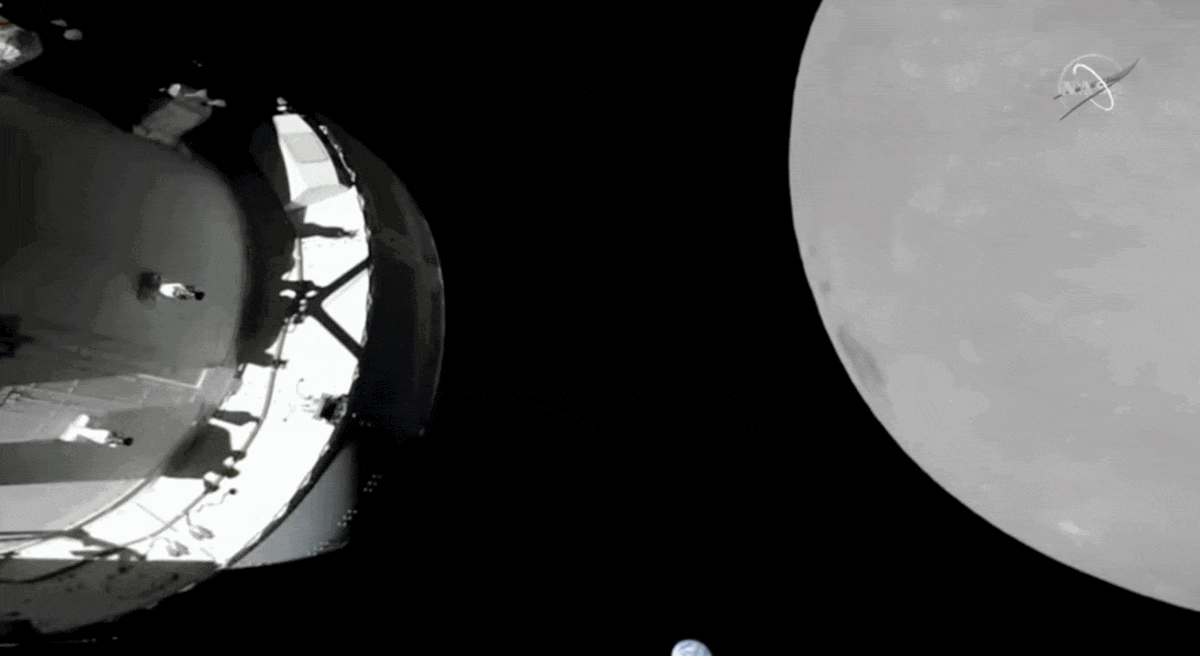See the First Stunning Photos of the Earth and Moon From Artemis 1
The uncrewed Orion spacecraft is equipped with 16 cameras that have been documenting its journey through space

After months of anticipation, NASA’s most powerful rocket launched the uncrewed Orion spacecraft to the moon last Wednesday. Since then, the vehicle—equipped with 16 cameras on its exterior and interior—has flown by the lunar surface and captured various stunning images of both the moon and Earth.
The 32-story Space Launch System (SLS) rocket propelled Orion, the vehicle intended to later carry astronauts, toward the moon from Cape Canaveral, Florida, at 1:47 a.m. Eastern time November 16. The launch initiated the Artemis 1 mission, NASA’s first major phase of its new lunar program, paving the way for astronauts to return to the moon.
Orion’s cameras are intended to collect essential data, document the mission and share images of the Earth and the moon from unique perspectives, according to a NASA statement. Videos and images captured by the spacecraft’s cameras will range from standard-definition to high-definition and 4K imagery.
“Images captured during the [Artemis] mission will be different than what humanity saw during Apollo missions, but capturing milestone events such as Earthrise, Orion’s farthest distance from Earth and lunar flyby will be a high priority,” David Melendrez, imagery integration lead for the Orion Program at NASA’s Johnson Space Center, says in the statement.
During the mission’s 25.5-day duration, Orion is expected to travel about 1.3 million miles—farther than any other spacecraft designed for humans has ever flown, according to NASA. If all goes according to plan, the craft will enter “distant retrograde orbit” on Friday, meaning that it will circle the moon in the opposite direction from the way the moon orbits Earth. It will remain there for approximately a week before making its return trip home.
Orion is expected to make a precision landing in the Pacific Ocean off the coast of Baja, California, on December 11 and await recovery from United States Navy divers and a NASA team.
Artemis 1 is just the beginning. The Artemis 2 flight, tentatively scheduled for 2024, will travel a similar path but carry human occupants. The Artemis 3 mission is slated for 2025 (though the date is likely to change) and will send humans—including the first woman and first person of color—to the lunar surface for the first time since 1972. These missions will lay the foundation for later human exploration of Mars.
Take a look at the first breathtaking images sent back from Orion’s cameras since the spacecraft took flight last week.
Earth from the Orion capsule
/https://tf-cmsv2-smithsonianmag-media.s3.amazonaws.com/filer_public/20/8a/208a9863-87b0-4b2a-86f5-6da96d7f8b68/orionart.jpeg)
Just nine hours after its successful launch, the Orion spacecraft snapped this photo of our home planet as it headed toward the moon. Artemis 1 serves as a test flight to ensure NASA’s equipment is safe for future astronauts, with the agency closely monitoring the spacecraft’s performance. Sensors on board are measuring how well human occupants might be protected from radiation, and the mission will test how the spacecraft’s heat shield survives the scorching temperatures created as it re-enters Earth’s atmosphere.
Orion takes a “selfie”
/https://tf-cmsv2-smithsonianmag-media.s3.amazonaws.com/filer_public/e5/74/e574afab-ffd8-4794-b01c-66bed57247d7/orionselfie.jpeg)
On the third day of the mission, Orion captured a “high-resolution selfie” during a routine inspection, using a camera mounted on its solar array wing, according to NASA. At the time, the uncrewed Orion spacecraft was more than halfway to the moon.
Earth in black and white
/https://tf-cmsv2-smithsonianmag-media.s3.amazonaws.com/filer_public/a2/d2/a2d211a5-467c-47a4-a3d1-1f4c00f77548/bwearth.jpeg)
Orion’s optical navigation camera captured black-and-white images of Earth on the second day of the mission. The spacecraft uses this instrument to snap pictures of the Earth and moon at varying distances and times. NASA hopes to use these images on future missions to determine the capsule’s position in space, and these early photos will help the space agency assess whether this strategy will be feasible.
The “pale blue dot”
/https://tf-cmsv2-smithsonianmag-media.s3.amazonaws.com/filer_public/72/53/7253cee9-9bbc-4022-a062-3bb4b24ad4cf/screenshot-earthrise.png)
At its farthest point, Orion is expected to reach up to 270,000 miles from Earth. Here, its distant view of the Earth against dark space elicits the 1990 image taken by NASA’s Voyager 1 spacecraft from beyond Neptune, which shows Earth as a “pale blue dot.”
Orion snaps a picture of the moon
/https://tf-cmsv2-smithsonianmag-media.s3.amazonaws.com/filer_public/de/82/de82658c-6a52-459f-bfd4-87d478911d00/moonorion.jpeg)
The uncrewed spacecraft made its closest flyby of the lunar surface early on Monday, passing 81 miles above the moon, per NASA. As it approached, Orion captured this photo. During the flyby, the capsule was more than 230,000 miles away from Earth.
The names Orion and Artemis stem from Greek mythology: Orion is a giant huntsman, and Artemis is the twin of the Greek god of the sun, Apollo. Likewise, the Artemis program is the modern counterpart of NASA’s Apollo program that landed the first humans on the moon and developed the space agency’s capacity to explore and study the lunar surface. On Monday, Orion flew past the Apollo 11 mission's Tranquility Base, the site of the first-ever moon landing.
/https://tf-cmsv2-smithsonianmag-media.s3.amazonaws.com/accounts/headshot/Jacquelyne_Germain_thumbnail_1.png)
/https://tf-cmsv2-smithsonianmag-media.s3.amazonaws.com/accounts/headshot/Jacquelyne_Germain_thumbnail_1.png)